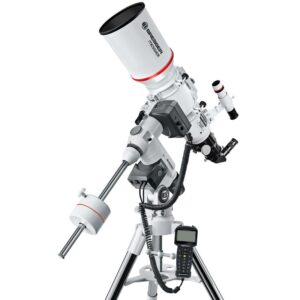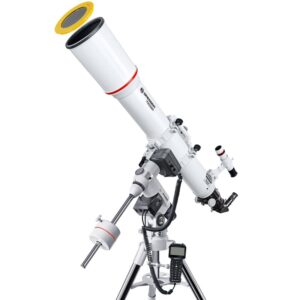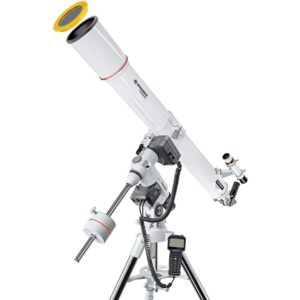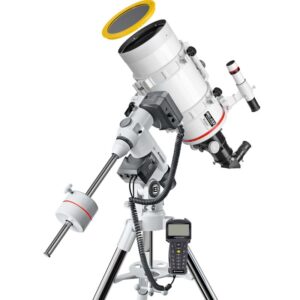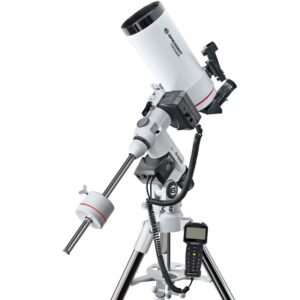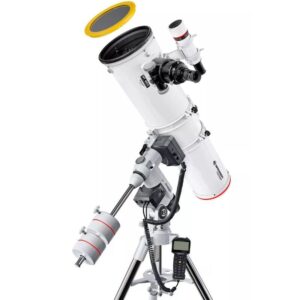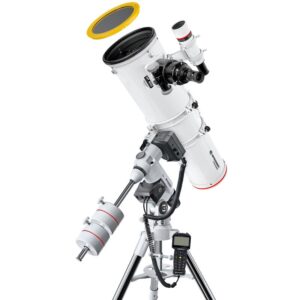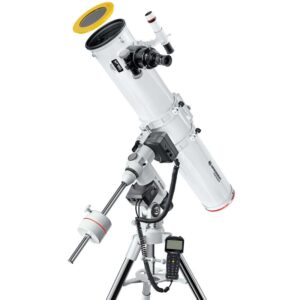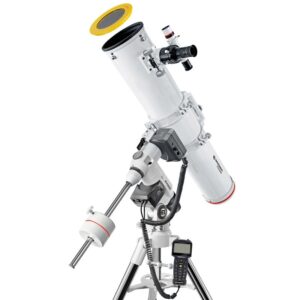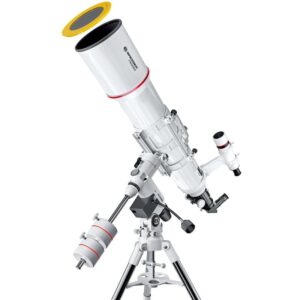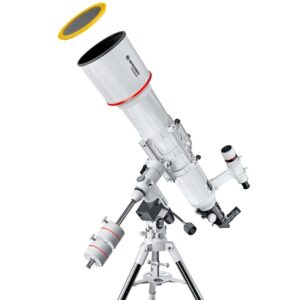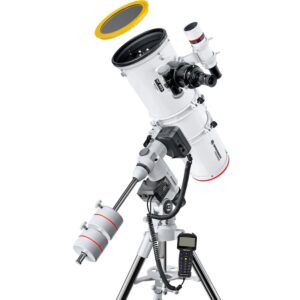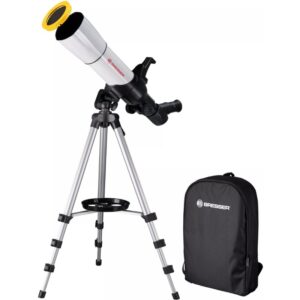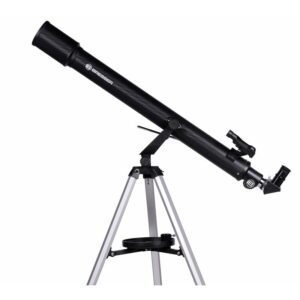Choosing the right telescope
The right telescope choosing immediately becomes easier if you answer a few key questions first. Don't stress: this is not a knowledge test, it just helps you quickly filter what really suits you. Below we walk through the questions and choices step by step.
1) How do you plan to use the telescope?
Your use purpose determines 80% of choice. Consider:
Daytime/nature observation: birds, ships, views. (Refractor + erecting prism makes the most sense here).
Moon & bright planets: Moon, Jupiter, Saturn, Venus, Mars (Refractor or Maksutov; Dobson will also do fine).
Deep-sky: nebulae, star clusters, galaxies. (Large aperture helps: Dobson or Newton reflector.)
Astrophotography: From smartphone on the Moon to deep-sky with long exposures. (Already need EQ mounts soon.)
Mix of everything: All-round viewing, occasional capture. (SCT/EdgeHD or compact refractor; pay attention to mount choice).
2) Where are you going to use it?
Backyard & up/down each time: choose something that you fast outside and also bring it back in. The best telescope is the one you often used.
Dark sky locations (travel): the telescope fits in your car and you can use it only set up? Consider a collapsible Dobson, a compact SCT or a short refractor. A transportation bag extends life and makes wearing easier.
Fixed setup/observatory: Then you can go bigger/serious (EQ mount on column, OTA of your choice).
3) Do you want to photograph (now or later)?
Smartphone photos Of Moon/planets via an adapter? You can do that with almost any stable alt-az-setup. Shutter speeds are short; earth rotation plays little part.
Deep-sky photography: choose one equatorial mount (EQ) with tracking. Preferably computerised (GoTo) for alignment, finding and tracking. Combine with a fast Newton (f/4-f/5), a APO refractor or a EdgeHD with reducer For a flat image plane.
4) What is your budget?
Telescopes range roughly from €100 to well past €10,000. It's not about what “exists,” but what logical is for your plans.
For children/beginners: choose one solid mount and enough aperture to really see something.
For adults/all-around: smooth moving, stable mount, enough opening for your purposes. For galaxies and nebulae, 4-5″ is the practical lower limit; 8″ Dobson is a popular “sweet spot.”.
Computer control (GoTo): raises the price, but lowers the threshold. If you can stretch it, pays comfort.
Astrophotography: most of the budget goes to mount precision, optical quality and electronics. The results these days are surprisingly close to semi-pro, provided your setup is correct.
5) “What is the best telescope to buy?”
There is no universal “best,” only the best for you, now. Today, that can be a 8″ Dobson be; a year from now, perhaps a EdgeHD on EQ. Your interests, location and comfort level change. Get a realistic choice you make often used.
What to look for in telescope specifications
Lens aperture
Old, but still good rule of thumb: Buy the largest opening that you can carry alone AND will use often.
More aperture = more light = more detail, especially on deep-sky. But: bigger is heavier. If you go out less often due to weight or hassle, you lose more than you gain.
Practical:
Lots of detail for little money? Dobson 8″ (200 mm) is the classic answer.
Portability + electronics? Look at SCT/EdgeHD (8-9.25″): a lot of focal point in a short tube.
High contrast on Moon/planets, low maintenance? Refractor (Entry-level achromatic, APO for premium/astrophoto).
Focal length & f/number
Long focal point → narrower field of view, higher magnification (planets/moon, small objects).
Short focal point → wider field of view (large nebulae/regions, wide-field photography).
f/number = focal length ÷ aperture. Smaller f-number (f/4-f/5) = wider field of view and faster For (deep-sky) photography.
SCT/EdgeHD are often f/10 (all-round); with reducer make them faster and wider for photo.
Mount choice (at least as important as the tube)
Alt-azimuth (Alt-Az)
Moving as you look: up/down, left/right - intuitive and ideal for visual.
Examples: Dobson (manual), NexStar SE (computerized Alt-Az).
Fine For Moon/planets photos with smartphone.
Not ideal For long deep-sky exposures (field rotation).
Equatorial (EQ)
Follows the sky with one axis; essential for astrophotography outside the solar system.
Manual can be visual; if you want pictures, choose GoTo/EQ.
Note load capacity: the mount must be OTA + camera + accessories large cope.
Buying only the tube (OTA)
Do you already have a good mount or are you building a custom setup? Then a OTA logical. Always check the weight relative to the capacity Of your mount (incl. cameras/guidescope).
A summary
Dobson (Newton on wooden base): maximum light per euro, visual deep-sky champion, simple use.
Newton on EQ: affordable and fast (f/4-f/5) for photography; requires collimation and good coma corrector.
Refractor: low maintenance, high contrast; APO For astrophoto, achromatic for entry/visual.
SCT/EdgeHD: compact, all-round, huge accessory ecosystems; with reducer deployable for photo.
Maksutov-Cassegrain: super on Moon/planets (long focal length, high contrast); less suitable for wide deep-sky photos.
Concrete starting recommendations (realistic and achievable)
“I want to see a lot for my money (visually).” 8″ Dobson With 25 mm + 10 mm eyepiece and a Barlow.
“I want to do pictures later, now first learn to look.” SCT 6-8″ on Alt-Az (NexStar) → later possibly to EQ.
“I want to photograph deep-sky directly: APO refractor 70-80 mm or Newton f/4-f/5 at GoTo EQ (with guiding & coma/flattener where necessary).
“Moon/planets only, compact: Mak 127 On Alt-Az or small EQ.
Frequently asked questions about telescopes
What is the most popular telescope?
The most popular telescope changes from year to year, but certain types remain timeless. The Dobson telescope has been a favorite of beginners and experienced observers alike for decades. Its simple design, large mirror at a competitive price and ease of use make it a logical choice for those who want to learn stargazing without complicated setups.
Another popular model is the Celestron NexStar 8SE - an automated Schmidt-Cassegrain telescope with 20 cm aperture. This telescope combines compactness with powerful optics and automatic object recognition via a smart app. Those who want something lighter can opt for the smaller NexStar SE models: ideal for those who value mobility.
How do you know if a telescope is good?
You can recognize a good telescope by three things:
Image quality - The Moon and planets should appear sharp and contrasty in focus, without excessive flicker or blur.
Stability - The mount should not wobble; a solid base is at least as important as the optics.
Expectation Management - A 70 mm telescope will not show details of distant galaxies, but it can reveal the rings of Saturn or the moons of Jupiter.
In short, a good telescope is the one that you enjoy watching with and that matches your expectations.
What is the best telescope?
There is no such thing as the “best” telescope. It depends entirely on what you want to do with it.
Want to the Moon, Jupiter or Saturn view? Then a refractor with a simple Alt-Az mount perfectly.
Want to astrophotography practicing? Then choose a telescope with a equatorial mount, possibly with motor control or GoTo.
Want to deep into space, then the larger the aperture, the more light and therefore more detail you see.
So the best telescope is the one you can afford, can set up yourself and will use regularly.
Can you see through a telescope with glasses?
Yes, you can - especially if you have a astigmatism have. Then choose eyepieces with sufficient eye relief (at least 15 mm, preferably 18-20 mm). This keeps the image comfortably visible without having to take off the glasses.
If you have an eyepiece with short eye relief, you can fold down the rubber eyecup or take the glasses off for a moment and focus without glasses.
What is the best telescope mount?
It depends on your goal:
For day and night viewers is a Alt-Azimuth mount ideal. This one simply moves up and down, left and right.
For astrophotography is a equatorial mount better. It follows the earth's rotation and keeps objects in focus accurately, which is essential in long exposures.
A stable mount with sufficient carrying capacity is more important than extra electronics. Well-known examples are the Celestron Advanced VX (EQ) and the Sky-Watcher AZ-GTi (Alt-Az, with GoTo function).
What telescope accessories do I need?
With the right accessories, you'll get more out of your telescope. Indispensable are:
Moon Filter - prevents glare and increases contrast.
Viewfinder or red dot finder - helps you find objects faster.
Additional eyepieces - For different magnifications.
Dew cap - prevents fogged lenses.
Power supply or power bank - Indispensable for electronic telescopes.
Star map or planisphere - convenient, even with GoTo systems.
Our Telescope accessories guide helps you choose which accessories make the difference for your setup.
Is it safe to look at the sun with a telescope?
Only with the right sunscreen or a dedicated solar telescope! Without protection it is perilous To look at the sun through a telescope.
Never use an old screw filter placed on the eyepiece - they may break or melt. Always mount a full sunscreen before on the telescope opening or use a special H-alpha solar telescope.
What does “atmospheric conditions” mean?
This refers to the atmospheric stability. Air currents, temperature differences and moisture affect how sharply you see celestial bodies. Even the best telescope can give a poor image in unsettled air.
On clear, stable nights, you can use higher magnifications; on poor seeing, lower magnifications are often better. A dew cap or dew tape helps keep the optics dew-free.
Summary:
Buying a telescope is not a matter of choosing the most expensive one, but of finding the right balance between aperture, stability and ease of use. Whether you choose a classic Dobson or a modern smart telescope, the most important thing is that you use it and keep using it.
Important telescope terms explained
Lens aperture
The aperture is the diameter of a telescope's primary lens or mirror, expressed in millimeters or inches. The larger the aperture, the more light the telescope captures. More light means more detail: fine structures on the Moon, the bands on Jupiter or faint nebulae become visible that disappear in the dark with a smaller telescope.
Dobson telescope
A Dobson telescope is a Newton reflector mounted on a simple, rotating wooden mount. John Dobson's design made stargazing accessible to all: large mirror area, low price and ease of use. These telescopes are still unmatched when it comes to “light output per dollar.” Perfect for those who want to observe visually without complex electronics.
EdgeHD telescope
The Celestron EdgeHD Series is the premium line within Schmidt-Cassegrain telescopes. These telescopes correct optical distortion, keeping stars in focus across the entire field of view - even when using a full-frame CMOS camera. Available in apertures from 8 to 14 inches, suitable for both visual observation and serious astrophotography.
Ocular
The eyepiece is the lens system through which you actually look. Each eyepiece has its own focal length (in mm) and thus determines the magnification: divide the focal length of the telescope by that of the eyepiece. For example, a 10 mm eyepiece on a telescope with 1000 mm focal length provides 100× magnification. Many observers have multiple eyepieces for different objects: low magnification for nebulae, high for planets.
Viewfinder scope
A viewfinder scope (or “finder”) is a small auxiliary viewer on top of the telescope that allows you to easily center objects. Some are simple red-dot finders; others resemble mini telescopes with crosshairs. A good finder makes the difference between frustration and ease in finding celestial bodies.
Focal length
The focal length is the distance between the primary lens or mirror and the point where light converges in focus. A longer focal length gives more magnification and a smaller field of view; a short focal length, on the other hand, shows a larger piece of sky. Refractors tend to have longer focal lengths than Newton reflectors, while Schmidt-Cassegrains fall in between.
F-ratio (f/value)
The f-ratio is calculated by dividing the focal length by the aperture. So a telescope of 1000 mm focal length with a 200 mm mirror has f/5.
Low f-values (f/4-f/6) → “fast” telescopes, suitable for photography and wide sky fields.
High f-values (f/8-f/12) → “slow” telescopes, ideal for planets and smaller objects.
So the f-value determines not only the luminosity, but also the type of observations you can best make.
Highest usable magnification
The highest usable magnification indicates how much you can magnify without the image becoming out of focus. A good rule of thumb is approximately 2× the aperture in millimeters (or 50× per inch). So a telescope with 100 mm aperture can provide a maximum of about 200× magnification, but only under good seeing conditions. The atmosphere often determines the limit, not the optics.
Imaging Newtonian
A Imaging Newtonian is a fast reflector (usually f/5 or lower) designed specifically for astrophotography. Thanks to its short focal length, exposure times are short and large objects such as the Orion Nebula fit nicely into view. Some models are designed exclusively for photography and come as a separate optical tube (OTA) to combine with a proprietary equatorial mount.
OTA (Optical Tube Assembly).
The abbreviation OTA means “Optical Tube.” This is the telescope itself, without a tripod or mount. Many astrophotographers buy only the OTA to put together their own setup with an existing mount or automated tracking platform.
Reflector telescope
A reflector uses mirrors to collect and focus light. The classic Newton reflector, named after Isaac Newton - is bright, affordable and popular with deep-sky enthusiasts. Its open construction does require occasional collimation (alignment of the mirrors) for optimal imaging.
Refractor telescope
A refractor works with lenses instead of mirrors. The simplest version, the achromate, uses two lenses but shows some color shifting on bright objects. A apochromatic (APO) has three or more lens elements and produces virtually color-neutral images, ideal for photography or critical planetary observation.
SCT (Schmidt-Cassegrain telescope).
A SCT is a catadioptric telescope: a combination of mirrors and lenses in a compact, folded light path. As a result, an SCT offers large aperture in a shorter tube, easy to transport and suitable for both visual observation and photography. Typical apertures are between 8 and 11 inches.
Finally, use wins from perfection
The best telescope is the one that more often outside state. So choose a combination of aperture + portability + mount that suits you and your location. In doubt? Send us your goals and situation; we'll give honest, practical advice, without empty promises, with realistic expectations.
Need help choosing your first telescope?
Our experts have a Telescope Decision Tree made. Check it out here on this page, and see at a glance which telescope fits your budget best.

